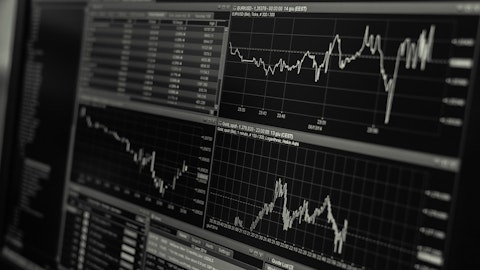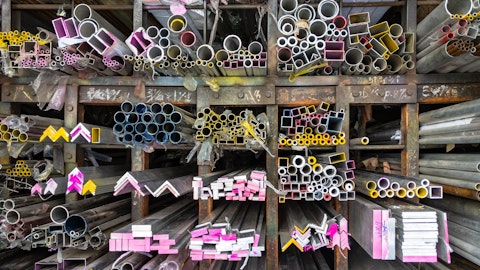Martin Englert: Question on conversion costs, they were pretty similar year-on-year around $465 per ton. Just wanted to see if what your thoughts were if this was a reasonable range to expect on a go-forward basis considering today’s operating structure, or is this something that has an opportunity to come down as start-up costs start to subside from some of the growth projects?
Dave Sumoski: Yes. This is Dave Sumoski. Certainly, some of the growth projects, especially Gallatin has – that’s increased our cost based on some of the things that we have done up there and some of the – it was a little bit slower but starting than we had expected. So, we can expect the costs to come down a little bit, but not a lot. I think Gelatin is running at a really good rate now, where I will say we were probably here near full run rate, so we are going to be in a good spot this year.
Martin Englert: Okay. And I just wanted to circle back on the discussion of plate and structural and this is from the mill perspective, looking at the plate volumes and the beam volumes. There was just year-on-year divergent trend when you look at the quarterly where you saw price come down in 4Q, but had been growing and then you have the opposite in structural products. Anything else to add there as far as color as to why those would have pivoted so differently through the course of the year?
Al Behr: Sure, Martin. Hey. This is Al Behr again. I will start with plate, so year-over-year growth, but you see same quarter year-over-year, we took a step back. A lot of that is just we are not going to chase cheap tons. And in Q4, we had some of the imports come in, and those spreads just got to be where we are not going to load our books with tons that aren’t profitable and aren’t going to drive returns for us. So, I think that will change as we move forward, and I spoke to our outlook for 2024 in plate. In beams, you saw a really great quarter of beams. Part of that speaks to the resiliency of the market and Brad spoke to that, and we have spoke to that. It just remains a resilient market, and there is plenty of areas of strength where we can go and compete and win and you see that.
But part of that is also the breadth of Nucor’s portfolio. And some of those tons, you see in the beam group are tons to our downstream customers, Skyline being one of them, that won some nice projects and you will see them ship those tons through the first half to say, convert and perform. So, there is just always – Nucor’s success is a multilayered story. There is always a cylinder firing. And the numbers that you see, I think just reflect that, especially on the beams side.
Martin Englert: Okay. I appreciate the color. Thank you and congratulations on the long-term return profile.
Leon Topalian: Thank you, Martin.
Operator: Next question comes from Tristan Gresser with BNP. Please go ahead.
Tristan Gresser: Yes. Hi. Thank you for taking my questions. The first one is on capital allocation, and thank you for touching on the M&A situation. If I could just have a quick follow-up there, when you look at the pipeline of opportunities, is it fair to assume the most – well, all those opportunities are inside the U.S. and you are not looking at opportunities abroad. And in the past, when you look at the balance between organic and inorganic, I wonder if you could comment a little bit where in the priority list, greenfield projects, you par essentially. That’s my first question. Thank you.
Leon Topalian: Tristan, I will kick it off and certainly let Steve Laxton and share any additional comments. But if you – as you look at our M&A pipeline, you think about our strategy. As we think about growing the core, expanding beyond, what we said is roughly we expect over the next 5 years, 6 years, that we would begin to generate about 20% to 25% of our overall revenues through expand beyond businesses. So, we are moving to that. So, it sort of gives you a rough breakdown to where you are going to see us continue to think about growth, where we are going to continue to channel our capital dollars. Regarding the geography, I would tell you, it’s probably a safe bet that Nucor is going to stay in North America though that’s the sector this economy that we know the best, where we have the most advantages to use the strength of Nucor from our culture, our team, our conversion model and understanding.
As the market leader in 12 of the 14 major steel market and categories, we have been in business a long time. We understand the boundaries around this industry, and we also understand our customers and where they are wanting to go. We are making investments not for our benefits. We are making investments not to be the largest by volume. We are being disciplined in those investments to create capability sets that our customers continue to grow their businesses and continue to flourish.
Tristan Gresser: Alright. That’s helpful. Moving on to maybe the rebar market, can you discuss a little bit the demand trends you have been seeing there over the past a couple of weeks? And we have seen the price hikes coming through, putting an end to some metal spread compression. Do you see any reason on the ground to expect further moderation, or you believe the market has now find kind of a new equilibrium there? Thank you.
John Hollatz: Yes. Tristan, this is John Hollatz. We did see some improved margins in rebar in the fourth quarter. And over the course of the year, rebar remained pretty steady as we have talked about these infrastructure projects and other demand and construction continuing to grow. We are bullish on the rebar market for the future.
Tristan Gresser: Okay. That’s clear. Maybe last question then on plate, I know it has been discussed a bit, but in your outlook, the weakness you are seeing in heavy equipment or earthmoving machinery, how new is that? How severe is it? And in terms of outlook, I think you mentioned something, you said it would be steady. Should I understand it as weakness – those incoming part of – portion of weakness being offset by more supported construction infrastructure that’s coming on?
Al Behr: Yes. Tristan, Al again. Is your question primarily just around that heavy equipment piece? I want to make sure I get that right.
Tristan Gresser: Yes, the kind of the red dot you put in the table and that includes heavy equipment, earth moving machinery. So, some weakness you are seeing there, just trying to figure out if that’s new and if it’s severe. And then when you look at the outlook for metal spreads for plate, they have been pretty steady in January. Is that something you expect to continue, or do you think that weakness you just flagged this could potentially imply some further moderation there?
Al Behr: Okay. Let me address the heavy equipment piece. My comments about it declining, I wouldn’t say are new in terms of the decline in that sector. That’s been happening through the second half of the year. I wouldn’t say we see that as a really strong decline going into 2024 because there is obviously the infrastructure, there is going to be some spending in that end-use market that will keep that somewhat buoy, but we do see it continuing to decline a bit as one of several end markets where we serve with plates. So, all of that put together with non-res construction and some of the other highlights that we talked about in those markets, our outlook for plate is relatively optimistic just in terms of small, like low-single digit incremental growth year-over-year, that there is plenty of different parts where we can compete separate from the ramp-up that we will have in Brandenburg, where we will grab some incremental time just to apply that alone.





